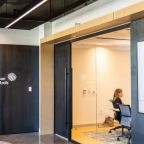Like many major societal events though, the pandemic will leave a legacy. In the case of the COVID-19 pandemic, that legacy will be significantly greater acceptance of remote working. Some employees might shift to complete remote work, it is likely that a great many more will end up with a split schedule, working from home several days a week and in the office the remaining days.
While the idea is simple, successful execution the hybrid workplace and shared desking requires attention to some operational details. Here are some tips and ideas for implementing aspects of individual and collaborative hybrid workplaces:
1). Clean Desks and Lockers
To successfully manage a shared desking workspace, employees cannot leave personal items in workspaces. Some organizations provide small lockers or rolling storage bins that can be used for personal items at the end of each day. There must also be a clean-desk policy that requires clearing of all personal items from workspaces at the end of the workday.
2). Open-Plan Desking versus Workstations
The use of what is called open-plan desking or benching has become a popular replacement for workstation cubicles in the last decade. Many designers believe that this creates a more active, live environment that is more appealing to work in.
The Coronavirus pandemic has placed the concept on hold since it does not provide sufficient worker separation, but some significant pushback to the concept was being seen even before the pandemic. The lack of privacy and the preponderance of interruptions were seen as a significant downside to the idea. This debate might not be settled for a while, but after the pandemic ends, we suggest considering the following:
- If you do opt for an open-plan design, keep the size of the individual workspace somewhat generous. A width of at least five feet is preferable, with some sort of privacy screen between employees facing each other, along with the possible inclusion of a worksurface return.
- People are different. Some people prefer more open, livelier work environments while others prefer enclosure and privacy. An office should incorporate a variety of workstation styles and encourage employee to find the workstation that suits them best for the work they are doing at the moment. For example, providing focus rooms or “phone booths” for use by employees when they have work that requires concentration or privacy can compensate for the drawbacks of open-plan design.
3). Focus Rooms and “Phone Booths”
Different tasks require different workspaces. To mitigate the problems of distraction in open-plan workspaces, many organizations are providing focus rooms or what are popularly being called “phone booths.” These are very small single person workstations with a glass or partial glass enclosure. They are not intended to be used all day but can provide a productive space for tasks requiring concentration or privacy.


4). Hoteling
Hoteling is the practice of providing a workspace that can be used for short periods of time. Many companies utilize a booking system that allows occupants to reserve these spaces for several hours or days. It is beneficial in ensuring that visitors, employees that usually work remotely and part-time employees are assured of adequate workspace without the expense of providing these individuals with full-time assigned workspace.
Hoteling can also be used for special workspaces such as focus rooms, allowing these spaces to be booked when needed.


5). Neighborhoods
One option workplace planners should consider is the use of “neighborhoods.” With this practice, groups of workstations are assigned to departments. Employees can choose to work at any workstation within their department’s neighborhood.
Benefits of this practice include:
- Making it easier to locate co-workers.
- Utilization analysis at the department level which can improve planning.
Downsides of the practice include:
- A reduction in random inter-departmental encounters, thus reducing opportunities for serendipitous innovation.
- Additional management time required to maintain the balance of seats needed for each department.
- Constraints on space utilization. The new hybrid workplace might result in greatly expanded remote working, but with departments deciding to have most of their employees work in the office on selected days. Departments would alternate their in-office days for overall space efficiency, but would need more space on their in-office days than would be available in a neighborhood.
6). Collaboration Space
The hallmark of modern office work is the portion of work done as a group effort. While scheduled meetings will continue to be used, there is significant value in unscheduled, unstructured encounters for sharing information and spawning innovation. A well-designed agile workspace will include spaces for two to three people to have short, impromptu discussions.
It has become common practice to accommodate this need with soft lounge-type seating or a breakout table and chairs in an open area. We suggest that consideration be given to providing spaces with acoustical privacy to avoid disruption of nearby workers. Also, easy-to-use computer monitor support to facilitate screen sharing from laptops should be considered.
7). Generational and Societal Workplace Preferences
There has been much attention given to the effect of generations on workplace preferences. We hear comments such as “Millennials don’t want to work in their father’s office.” While there is some truth to this view, it is a generalization and probably an over-simplification. If by “father’s office” we mean the endless gray “cube farms” of the ‘90’s, it is likely that no one wants to work in those environments. Also we are seeing changes in societal workplace preferences that we interpret as generationally specific, but are actually true across generations.
8). Creative Design
One of the beneficial byproducts of the co-working movement is the emphasis on creative or “cool” design. The repetitive gray “cube farms” of twenty years ago are now widely seen as detriments to attracting and retaining talent. Design elements that should be considered include:
- The use of natural materials such as stone and natural wood
- Color, particularly used as accents
- Daylight
- Exposed structure and HVAC ductwork
- Use of talented interior architects and designers
- Plants and “green walls”
- Incorporation of fun spaces
There is one caution to be mindful of. The use of exposed structure instead of acoustical ceilings can result in noisy spaces. This can be mitigated somewhat with the use of acoustical “sound clouds” or baffles and white-noise systems. Just remember that those acoustical ceilings and furniture partitions were there for an acoustical reason and removing them can result in unintended consequences.
9). Cloud-Based Information Systems
For unassigned workspace to be effective, documents must be available electronically and not depend on paper files. In addition, computer access must be supported from anywhere, so offices will need either widespread use of laptops or roaming profiles deployed on standard desktops, so employees are not tied to specific computers. Finally, the use of information systems that are cloud-based will facilitate easy transition between workplaces and between home and office.
10). Co-Working
A recent addition to agile workspace practices has been the popularity of co-working, which is the practice of people from different companies sharing a common workspace. This concept emerged from technology incubators that were designed to provide workspace for start-up companies with uncertain futures without expensive tenant fit-out or long-term leases. The idea first gained popularity with freelance creative professionals and became widely known through the company WeWork. Before the pandemic, co-working had become an accepted solution for companies of all sizes to trim out space needs without the burden of long-term commitments.
During the pandemic, co-working spaces have been either shut down or greatly constrained due to the high level of social interaction associated with co-working space design. When the pandemic is over however, it is likely that co-working will regain its popularity, largely driven by the need for workplace and real estate flexibility.
Much about the future is uncertain, but business will continue valuing effectiveness, efficiency and flexibility in their workplaces. The hybrid workplace that combines the flexibility and efficiency of shared workplaces with liberal remote work practices meets all three criteria.
For an in-depth dive into how hoteling solutions can bolster your flexible work strategy, watch our on-demand product demo Workplace Management Solutions: Hoteling & Room Scheduling.













